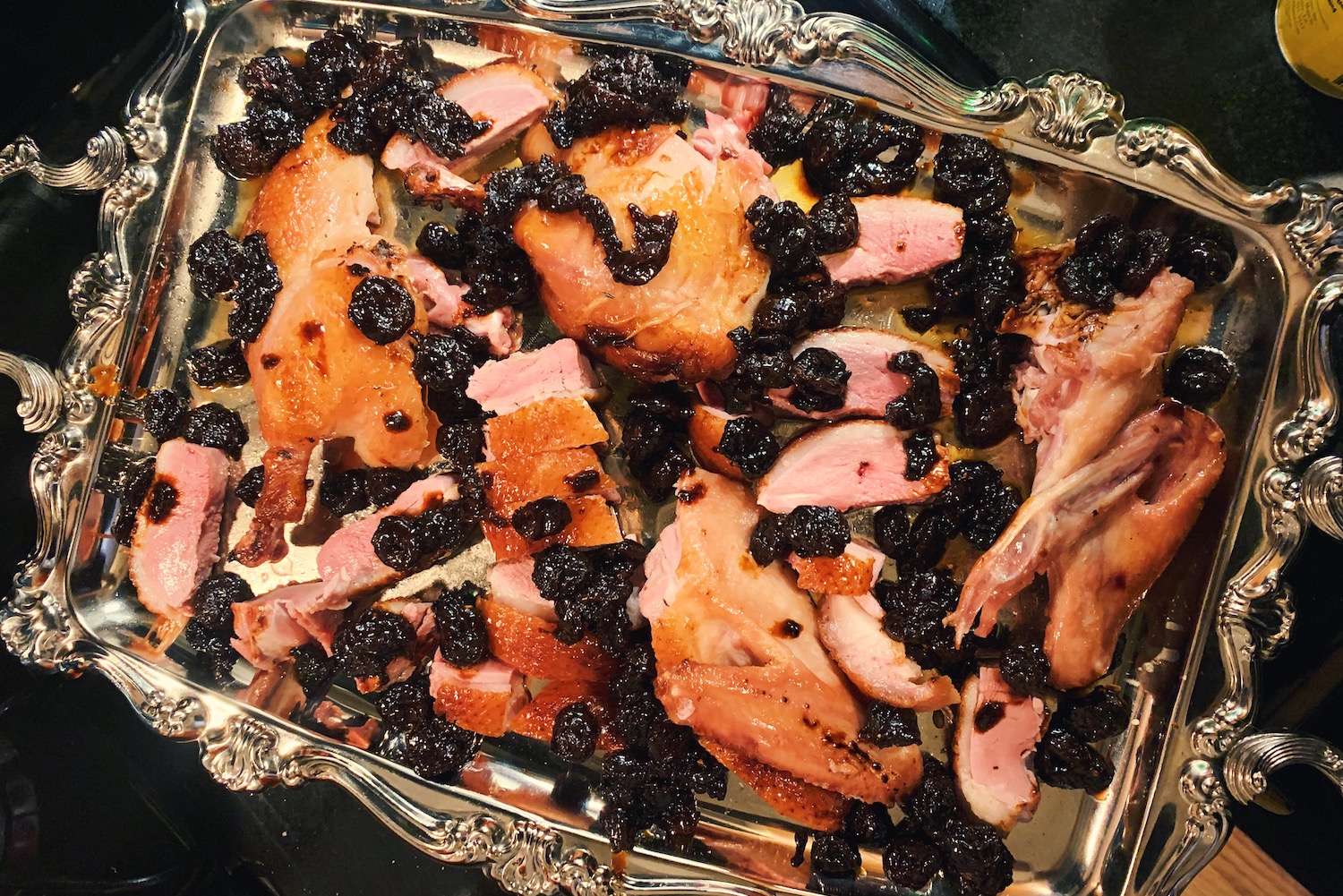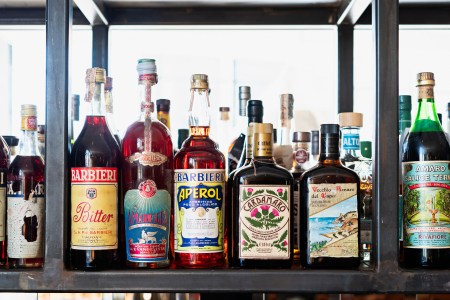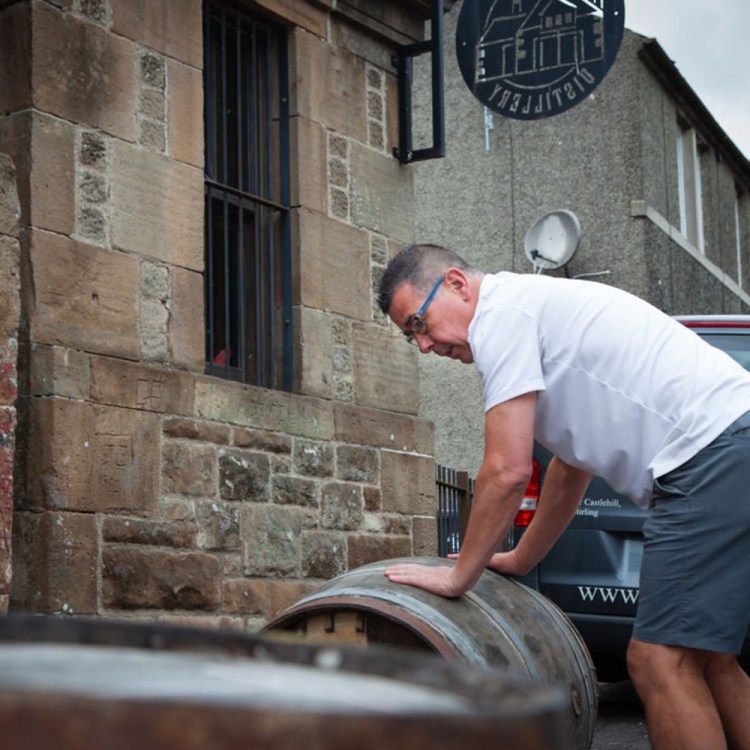Hosting Thanksgiving has its perks. There’s the very obvious benefit of not needing to leave your house to fight holiday crowds during one of the biggest travel weeks of the year. You, the host, dictate the timing and the guest list. And, best of all, you control the meal, meaning it’s not necessary to eat turkey, again, for the 35th year in a row.
I’ve been hosting Thanksgiving for the last five years, and after the first two, I convinced my husband to let me make a duck instead of a turkey. Don’t get me wrong, turkey is tasty, but holidays are for flexing. I want to make something that I typically don’t whip up for an average weekend dinner party earlier in the year. I want a showstopper, a centerpiece that guests will delightfully remember once the holidays have passed.
So I started paging through my cookbooks, looking for my showstopper. Of course, where I found it was in a cookbook that’s full of showstoppers, chef Angie Mar’s Butcher and Beast: Mastering the Art of Meat. That’s the first year I made her Roast Duck Flambé, and I haven’t looked back since.
I first met Mar when she was at the helm of The Beatrice Inn, an iconic restaurant that she purchased from Graydon Carter in 2016 after running the kitchen for three years. Mar invited me into The Bea to learn how to butcher a crown roast, and the restaurant quickly became one of my favorites in the city for its opulent menu and buzzing energy — it was a showstopper, if you will.
The Beatrice Inn closed in 2021, but Mar opened a new restaurant in the space next door, Le B., whose name is a nod to the original, which would be 100 years old this year. The menu is just as decadent, with dishes like Dungeness Crab Wellington and a jasmine tea-smoked duckling with Seckel pear.
But back to that Thanksgiving duck. Last year, I switched up the recipe by dressing the bird with a coriander-honey glaze, but I’m going back to Mar’s cherry jus this year. The prep begins four days before the feast by curing the duck, a technique that Mar got from her father. “That recipe goes back to the duck that my dad and brother-in-law used to make for the holidays, and they used to cure it and smoke it,” she says. “It was something we all looked forward to. I wanted to come up with something similar for The Bea, so I took the flavors of that childhood dish and modernized it. The result was a silky ham-like texture.”
Silky is an understatement. The cure gives the duck a deeply savory flavor and melt-in-your-mouth texture that you’d be hard-pressed to create from roasting alone. And unlike turkey, duck is a highly forgiving meat — it’s very difficult to dry out, especially if you don’t stray from Mar’s recipe.
I serve it with all of the usual sides, including my Mom’s venison and chestnut stuffing and roasted sweet potatoes, which could greatly benefit from a little duck fat. “I always suggest you utilize all parts of the bird, so the rendered fat leftover from this recipe is perfect for roasted potatoes,” Mar says. “And to drink, I would suggest a Beaujolais.”
If you’re looking to switch it up this year, give Mar’s Roast Duck Flambé recipe a go. It might just become your go-to showstopper for the feast.
Your New Thanksgiving Tradition Should Be a Post-Dinner Amaro
The Italian digestif will help with your food coma and give you an excuse to keep hanging out
Roast Duck Flambé by Angie Mar
Servings: 4
Ingredients
- .25 cup plus 2 tsp. (59 g) granulated sugar
- 2 Tbsp. plus 2 tsp. (41 g) dark brown sugar
- 3 Tbsp. plus 1 tsp. (28 g) kosher salt
- 3 Tbsp. (60 g) smoked sea salt
- 1.5 tsp. (9 g) pink curing salt
- 1 whole duck (5 to 6 pounds), preferably Pekin
- Cherrywood chips, for smoking
- 1 bunch thyme
- .25 cup Cognac or brandy
- 6 cups duck stock
- 10 oz. dried cherries (2 cups)
- Kosher salt and freshly ground black pepper
Directions
-
Cure the duck
-
In a large bowl, combine the granulated sugar, brown sugar, kosher salt, smoked salt and pink curing salt.
-
Remove the neck from the duck and set aside for the sauce (discard the giblets). Add the duck to the bowl of cure. With gloved hands, rub every inch of the duck, inside and out, with the cure mix. Use all of it. Cover the bowl with plastic wrap and cure in the refrigerator for 4 days, turning once for evenness.
-
-
Smoke the duck
-
Remove the duck from the refrigerator. Cold-smoke with the cherrywood chips for 20 minutes, until the duck has absorbed the smoky flavor.
-
-
Roast the duck
-
On the day of cooking, place the duck on a roasting rack set over a rimmed baking sheet. Do not rinse the duck. Stuff the duck’s cavity with the thyme and truss it.
-
Position a rack in the center and lower third of the oven and preheat the oven to 325°F. Place a baking dish with 2 inches of water on the lower rack as the oven preheats.
-
Roast the duck until the fat has rendered slightly and the skin begins to turn a deep golden, about 20 minutes. Remove it from the oven and also remove the water bath. Increase the oven temperature to 425°F. Allow the duck to rest for 20 minutes somewhere warm.
-
Return the duck to the oven (without the water bath) and continue cooking until the skin begins to crisp and it reaches a deep mahogany brown, about 15 minutes. Remove the duck from the oven and let rest for 10 minutes.
-
-
Make the cherry jus
-
In a medium saucepan over medium heat, sear the reserved duck neck until very dark, about 10 minutes. Pour off any fat that has rendered, but leave the neck in the pan. Add the duck stock, bring to a simmer and deglaze the pan, scraping up any browned bits from the bottom. Increase the heat to high and bring to a boil, then reduce the heat to medium-low and simmer, skimming off any impurities, until the liquid is reduced by half, 15 to 20 minutes. Strain the stock, discarding the solids, and return the liquid to the pot.
-
Reduce the heat to medium-low, add the dried cherries and simmer until the liquid is reduced by half again and the cherries are rehydrated, about 15 minutes. Season with salt and pepper to taste. Hold the sauce over very low heat.
-
-
Flambé the duck, in front of an audience, if possible
-
Remove the trussing twine and transfer the roasted duck to a clean flameproof dish or serving platter. Pour the Cognac into a small saucepan over medium heat and ignite the fumes with a barbecue lighter. Pour the flaming alcohol evenly over the duck; it should burn for about 10 seconds before the flame dissipates.
-
Transfer the flambéed duck to a cutting board and break it down: Slice off the legs and wings (they will be pink from the curing salt — don’t be alarmed), and then the breasts, which you can slice into individual pieces, about .5 inch thick. Stir any leftover juices from the flambé into the cherry jus. Arrange the sliced duck on a serving platter and spoon the sauce around it.
-
Every Thursday, our resident experts see to it that you’re up to date on the latest from the world of drinks. Trend reports, bottle reviews, cocktail recipes and more. Sign up for THE SPILL now.

























